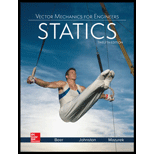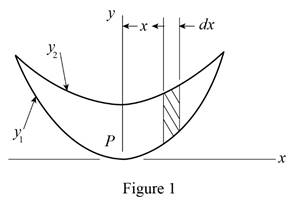
Concept explainers
9.23 and 9.24 Determine the polar moment of inertia and the polar radius of gyration of the shaded area shown with respect to point P.

Fig. P9.23
Find the polar moment of inertia and polar radius of gyration of the shaded area shown with respect to point P.
Answer to Problem 9.23P
The polar moment of inertia of the shaded area shown with respect to point P is
The polar radius of gyration of the shaded area shown with respect to point P is
Explanation of Solution
Given information:
The equation of the curve is
The equation of the curve is
Calculation:
Sketch the vertical strip shaded portion as shown in Figure 1.

Write the curve
Write the curve
Refer to Figure 1.
At
For
Find the constant
Substitute
Substitute 0 for x and a for y in Equation (2).
Refer to Figure 1.
At
For
Find the constant
Substitute
Substitute
Substitute
Determine the area of the strip element
Substitute
Find the shaded area (A) using the relation:
Substitute
Determine the moment of inertia
Refer Equation 9.2 in section 9.1B determining the moment of inertia of an area by integration:
Substitute
Integrate Equation (6) with respect to x.
Determine the moment of inertia
Integrate Equation (7) with respect to x.
Find the polar moment of inertia
Here,
Substitute
Thus, the polar moment of inertia of the shaded area shown with respect to point P is
Find the polar radius of gyration of the shaded area shown with respect to point P.
Here,
Substitute
Thus, the polar radius of gyration of the shaded area shown with respect to point P is
Want to see more full solutions like this?
Chapter 9 Solutions
Vector Mechanics for Engineers: Statics
- Determine by direct integration the moment of inertia of the shaded area with respect to the x axis.Fig. P9.11arrow_forwardIt is known that for a given area Iy = 48 x 106 mm4 and Ixy = -20 x 106 mm4, where the x and y axes are rectangular centroidal axes. If the axis corresponding to the maximum product of inertia is obtained by rotating the x axis 67.5° counterclockwise about C , use Mohr’s circle to determine (a) the moment of inertia Ix of the area, (b) the principal centroidal moments of inertia.arrow_forwardConsidering L = 50 + a + 2·b + c {mm}, determine the centroidal coordinate Ycg (location of the x´ axis of the centroid) and the moment of inertia is relative to the X´ axis (IX' , ). Assume a minimum precision of 6 significant figures and present the results of the moments of inertia in scientific notation (1.23456·10n ). (Knowing that a=7, b=1, and c=1.) Ycg = IX, =arrow_forward
- Two 20-mm steel plates are welded to a rolled S section as shown. Determine the moments of inertia and the radii of gyration of the combined section with respect to the centroidal x and y axes.arrow_forwardTwo 20-mm steel plates are welded to a rolled S section as shown.Determine the moments of inertia and the radii of gyration of the combined section with respect to the centroidal x and y axes.arrow_forwardTwo L4 x 4 x 1/2-in angles are welded to a steel plate as shown. Determine the moments of inertia of the combined section with respect to centroidal axes respectively parallel and perpendicular to the plate.arrow_forward
- Two L4 × 4 × 1/2-in. angles are welded to a steel plate as shown.Determine the moments of inertia of the combined section with respect to the centroidal axes that are respectively parallel and perpendicular to the plate.arrow_forwardA thin steel wire is bent into the shape shown. Denoting the mass per unit length of the wire by m’, determine by direct integration the mass moment of inertia of the wire with respect to each of the coordinate axes.arrow_forwardDetermine the moment of inertia and radius of gyration of the shaded area shown with respect to the x axis.Fig. P9.9arrow_forward
- A farmer constructs a trough by welding a rectangular piece of 2-mm-thick sheet steel to half of a steel drum. Knowing that the density of steel is 7850 kg/m3 and that the thickness of the walls of the drum is 1.8 mm, determine the mass moment of inertia of the trough with respect to each of the coordinate axes. Neglect the mass of the welds.arrow_forwardDetermine the moment of inertia (in4) Ix of the area shown with respect to the horizontal line that passes to the centroid of the composite area if b= 6.11 in, h= 0.72 in, L= 8.39 in, and W = 0.77 in. Round off only on the final answer expressed in 3 decimal places.arrow_forwarddetermine the centroidal polar moment of inertia of a rectangle 100mm wide by 200 mm higharrow_forward
 Elements Of ElectromagneticsMechanical EngineeringISBN:9780190698614Author:Sadiku, Matthew N. O.Publisher:Oxford University Press
Elements Of ElectromagneticsMechanical EngineeringISBN:9780190698614Author:Sadiku, Matthew N. O.Publisher:Oxford University Press Mechanics of Materials (10th Edition)Mechanical EngineeringISBN:9780134319650Author:Russell C. HibbelerPublisher:PEARSON
Mechanics of Materials (10th Edition)Mechanical EngineeringISBN:9780134319650Author:Russell C. HibbelerPublisher:PEARSON Thermodynamics: An Engineering ApproachMechanical EngineeringISBN:9781259822674Author:Yunus A. Cengel Dr., Michael A. BolesPublisher:McGraw-Hill Education
Thermodynamics: An Engineering ApproachMechanical EngineeringISBN:9781259822674Author:Yunus A. Cengel Dr., Michael A. BolesPublisher:McGraw-Hill Education Control Systems EngineeringMechanical EngineeringISBN:9781118170519Author:Norman S. NisePublisher:WILEY
Control Systems EngineeringMechanical EngineeringISBN:9781118170519Author:Norman S. NisePublisher:WILEY Mechanics of Materials (MindTap Course List)Mechanical EngineeringISBN:9781337093347Author:Barry J. Goodno, James M. GerePublisher:Cengage Learning
Mechanics of Materials (MindTap Course List)Mechanical EngineeringISBN:9781337093347Author:Barry J. Goodno, James M. GerePublisher:Cengage Learning Engineering Mechanics: StaticsMechanical EngineeringISBN:9781118807330Author:James L. Meriam, L. G. Kraige, J. N. BoltonPublisher:WILEY
Engineering Mechanics: StaticsMechanical EngineeringISBN:9781118807330Author:James L. Meriam, L. G. Kraige, J. N. BoltonPublisher:WILEY





